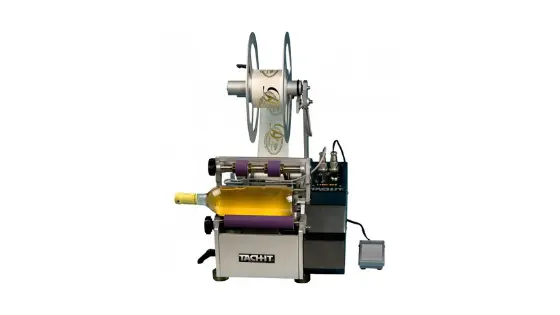Choosing the Right Label Applicator for your labeling setup

When you scale your label production and print more labels, you will notice that hand labeling won’t cut it anymore. In our experience, after manual labeling a couple hundred labels by hand you will find your hand cramping up. With manual labeling by hand, you will find the labels not aligned straight when lined up making your brand look amateurish.
When choosing a label applicator, you want to ensure that it works with the type of bottle or packaging you are applying it to. There are typically two types – round bottle applicators and flat surface applicators.
The initial price of label applicators may seem costly, but over time save you lots of time saved while maintaining uniform labels for your products and brand.
There are a variety of different label applicators, some that are rated for couple hundred a day and some that are more catered for small and home-based businesses.
Certain applicators work with specific label rolls with certain core sizes. If you’re printing labels roll to roll then loading the finished labels on to the applicator, ensure that the size of the core fits into the applicator.
Bottle label applicators are typically used to label bottles as they will save you time and keep a consistent placement bottle to bottle. This is especially important if you are using personalized custom labels as the aesthetics of your product can be just as important as the taste.
Semi-Automatic vs. Manual Operation
When you are going to be labeling hundreds of bottles a day, a semi-automatic label applicator is going to be a huge time saver for your business
This will save you a lot of money and will greatly increase your return on investment.
With a manual operated label applicator, they will still save you a ton of time. And like a Semi-automatic, you will have the advantage of label accuracy. The biggest advantage is the costs savings when you go with a manual operator.
Semi-automatic machines will drastically save you time on every unit that needs labeling – a big advantage if you are going to be running a business.
In the end, both are going to produce the same results, but the semi-automatic machines will save you time on every bottle vs a manual one that requires hand operation.
Maxwolf Semi Automatic Round Bottle Labeling Machine
The Maxwolf is a semi-automatic labeling machine that’s electronically powered for fast application and accurate labeling. It is relatively easy to setup out of the box and calibrate accurately.
With this unit, it supports large labels and bottle lengths of different sizes. Depending on the size, it can label as many as 40 bottles per minute.
Since this is an electrical unit, you will need to set it up near an wall outlet to use it.
ZLA Zap Labeler: Semi-Automatic Labeling Machine
The Zap Labeler is another semi-automatic label applicator that’s great for bottles and flat surfaces. It also works with hex and oval bottles as well as bags and pouches. If your product has an irregular packing shape, this machine is more advantageous.
With the Zap Labeler, it is compatible with labels with a 3-inch core and supports wide labels.
While unpacking this unit, we didn’t find any setup instructions, so it took a while for us to set up and assemble the unit together. If you get the orientation wrong, the label will get skewed and you will think you got ripped off. The manufacture’s website has a bunch of different videos to clear things up for you.
The Zap label applicator machine a great solution for the small to mid-sized label operations. The costs of one is about a fraction of what others cost and will handle most bottle shapes. It also won’t add to your energy bills as it’s a manual labeler.
START International LAB01 Manual Bottle Label Applicator
The LAB01 Manual Bottle Applicator requires manual loading and turning for each bottle and only works with round bottles.
To operate the unit, you will need to load the printed labels then place the bottle onto the roller. Then turn the bottle until the label is applied and load on the next bottle. This unit has a sleek design and supports most bottle sizes on the market. It’s easy to operate and hold hundreds of labels for each cycle.
This device is designed for labeling bottle faces only and requires manual operation. It is also limited to traditional label sizes.
The Bottom Line
A label applicator will streamline your production process and save you cost in the long run. Hand applying labels only work for small quantities, but you’ll find as you reach a certain point you will need either a semi-automatic or manual label applicator. A semi-automatic will help automate some of the process, while a manual applicator will require hand operation. However in the end, both methods will be more effective than hand applying labels.

John McIntyre, Writer
Daniel is a American who grew up to be a nerd with a philosophy degree and too many hobbies to count. He emigrated from California to New York in 2013. While he is not writing he is busy taking care of his two kids Claire and Vicky.